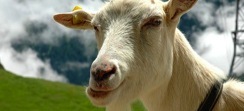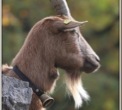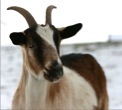Photo by nbraier


Photo by
~Mclaire~
Photo by HeyThereSpaceman
Photo by wYnand!
Capra hircus, the domestic goat, is a very commonly known animal with a wide ecological spread. Children often first encounter this inquisitive, furry creature on their first trip to the petting zoo, and quickly learn the goat’s eager eating habits as it accepts whatever type of food they offer. The goat was first domesticated thousands of years ago in Western Asia and has since spread to nearly every area of the globe. Capra hircus has been referred to as its common name, the goat, since this time. The goat was later given its Latin name, Capra hircus, by Carl Linnaeus in 1758.
The domestic goat varies dramatically in size by breed, ranging from 9-113 kilograms in weight and 26-107 centimeters in height. The average goat is 45 kilograms in weight and 64 centimeters tall. The goat also varies in coat color, displaying coats of white, black, red, and brown or a combinations of many of these colors. Though their size and colors vary, all breeds of goats share a long, flat tail and long, pointed ears. Males have chin beards and are considerably larger than their female counter parts. All males also have horns which increase in length and weight with age, but in the domestic setting, these horns are often removed as a safety precaution.
To learn about a goat’s classification, click here.
To learn about other organisms at MultipleOrganisms.net, click here.
*within the content pages of this site, any animal common names highlighted in pink are links that will lead to
other MultipleOrganism.net pages



